Over 185 reports from 3 countries
The AMS and its international partner the International Meteor Organization (IMO) received more than 185 reports so far about a fireball event that occurred over Cyprus on January 21th, 2019 around 20:06 UT (22:06 Eastern European Time). The AMS #2020-485 event was mainly seen from the island of Cyprus in the Eastern Mediterranean but we also received reports from Lebanon (from Beirut) and Israel (from Rakefet and I’billin).
Submit an Official Fireball Report
If you want to learn more about Fireballs: read our Fireball FAQ.

Trajectory, Velocity and Energy
The preliminary trajectory computed based on all the reports submitted to the AMS and the IMO so far shows that the fireball was traveling from North East to South West and ended its flight somewhere over the Mediterranean Sea (South of Cyprus). NASA’s CNEOS (Center for Near Earth Object Studies) later confirmed the location of the event and was able to calculate a source energy of about 100t of TNT as well as a velocity of 27.4 km/s.
Many witnesses sent us videos of the event. All of them are visible on the corresponding event page.
Fireball, Meteorite…?
Several thousand meteors of fireball magnitude occur in the Earth’s atmosphere each day. The vast majority of these, however, occur over the oceans and uninhabited regions, and a good many are masked by daylight. Those that occur at night also stand little chance of being detected due to the relatively low numbers of persons out to notice them.
Additionally, the brighter the fireball, the more rare is the event. As a general thumb rule, there are only about 1/3 as many fireballs present for each successively brighter magnitude class, following an exponential decrease. Experienced observers can expect to see only about 1 fireball of magnitude -6 or better for every 200 hours of meteor observing, while a fireball of magnitude -4 can be expected about once every 20 hours or so.
